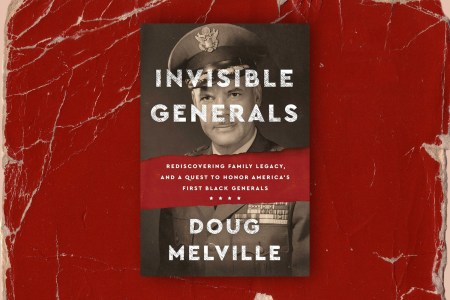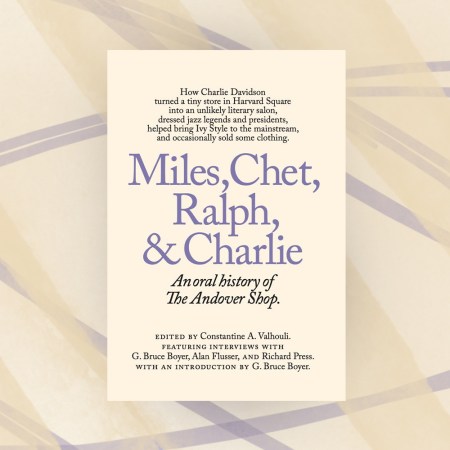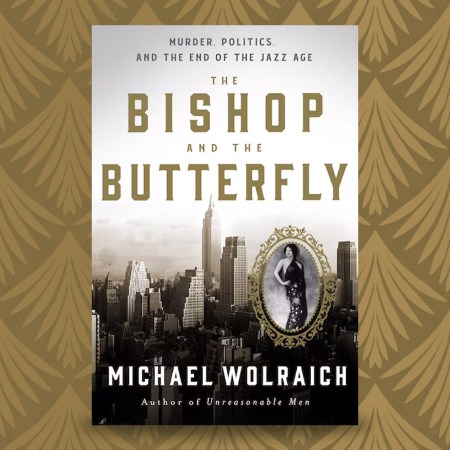Even if you didn’t know about their long history as collaborators, you could probably guess that writers Tom Clavin and Bob Drury have been working together for a while just from hearing them speak. The two writers — whose collaborations have earned them critical acclaim and spots on the bestseller lists — have an easygoing rapport and plenty of stories to tell.
Their latest book, Throne of Grace: A Mountain Man, an Epic Adventure, and the Bloody Conquest of the American West, uses the life story of mountain man Jedediah Smith to explore a singular period in American history — one where what is now the western United States was the staging ground for an economic conflict between the United States and the British.
Combine that with a series of harrowing bear attacks, a terrifying recipe for frontier whiskey and enough political intrigue to supply an HBO series, and you have the complex and thrilling history recounted in this book. InsideHook spoke with Drury and Clavin about unearthing this lost history of the American West.
InsideHook: Throne of Grace is far from your first collaboration. How did the two of you start working together?
Tom Clavin: Bob and I knew each other years ago, back in the ’90s. We were both reporters in New York, and so we’d cross paths from time to time and became friendly. Around, I’m going to say 2002 or 2003, Bob and I were both living in communities near each other. There was a favorite watering hole that was mostly attended by writers and cops, and we used to see each other there.
I remember coming in one day. I had read a story about a typhoon that struck the Third Fleet under Admiral Halsey in 1944. I’d never heard of it before. I came in, I was telling Bob what I had read, and he was very interested. He was a Men’s Journal contract reporter at the time, and he said, “Why don’t we collaborate? I’ll run it past my editor and collaborate on an article on this typhoon that nobody’s ever heard of.” So we did, and the article came out very well and had a lot of detail, and Men’s Journal gave us a lot of space.
That turned into a book contract, and that turned into our first book together, Halsey’s Typhoon, which came out in 2007. As soon as it came out, it immediately went to the New York Times bestseller list. It seemed like we had something good going, so we ended up doing another book together and then another book. I believe our new one, Throne of Grace, is our eighth book together. It could be the ninth. I don’t keep track.
Do you each tend to focus on the same things, or does it vary from book to book?
Clavin: No, we have our set ways of doing things that we established right at the beginning with Halsey’s Typhoon, which is that you can’t have four hands on the keyboard. So I do the majority of the research and the organizing and set things up and then pass it over to Bob, and Bob is the person who does the writing. I do the vast majority of the work and Bob takes the credit. (laughs) That’s pretty much it.
In this new book, you talk about Jedediah Smith and make the argument that he has perhaps not been as well-known as some of his contemporaries. How did you first find yourself reading about him? Was there a eureka moment where you realized that he was someone whose story would be compelling as a book?
Bob Drury: First of all, the idea of the book was all Tom’s. We get our ideas sometimes from the craziest places. We were having dinner with a marine historian once, thanking him for the help he gave us on our book The Last Stand of Fox Company, and he basically said to us, “What’s your next project?” We were humming and hawing and humming and humming and humming. And he said, “You should look into this Sioux warrior, Chief Red Cloud, the only Indian to ever win a war against the United States.”
Tom and I were looking at each other saying, “Huh?” We knew about Tecumseh, Crazy Horse, Sitting Bull, all those Apaches who, for a brief period, had the U.S. Cavalry cowed. Sure enough, we looked into Red Cloud and the book became The Heart of Everything That Is. It spent 25 weeks on the Times list.
This was all Tom’s idea. We were actually working on another World War II book. Tom said, “We have the makings of a trilogy.” We tend to write biographies of eras and not of men, but we need guides through those eras. So in Blood and Treasure, we used Daniel Boone to guide us through the pre-revolutionary era and the revolutionary era. Red Cloud, we used as our guide through the late 19th century Indian War era.
Tom said, “We have a half century in between these two. We could do a trilogy. We just have to find out, A, is the era worth writing about? And B, who is going to be our guide?” So as we looked into what was happening in that half-century between the Lewis and Clark expedition, which began in 1804 and lasted two years, and the California Gold Rush of 1849, we were astounded that most Americans, including us, had no idea about the violent mechanizations that were going on west of the Mississippi River.
Up in the northwest, the Oregon country — not the Oregon territory that became the state of Oregon, but the Oregon country of Washington, Oregon, Idaho, a slice of western Montana, the top of Utah and Nevada — there was a Cold War going on between the United States and Great Britain about who was going to colonize, basically who was going to steal the land from the indigenous peoples.
Even though the Alamo was decades away, and the Texas independence movement, and 10 years after that, the Mexican-American War, already politicians and business magnates and especially the railroad people were glancing covetously at Texas, New Mexico, Arizona and especially California. Tom said, “There’s a story here. We just have to find someone to take us through it.”
Clavin: Jim Bridger, for example, was a prominent character in The Heart of Everything That Is. So we felt there was not much new we could do with him as far as making him a central character. I think with some of the others too, they did not compare to Jedidiah Smith. The more we read about him, we were struck by the trips he made to the West Coast and back, the tremendous survival skills he displayed, his intelligence, the resilience that he had and his leadership ability. He was still a young man in his 20s, and he was leading these large companies of fur trappers and beaver hunters.
And he just was atypical. He was a mountain man. He was a respected mountain man. He could find his way around the American West, seemingly just being able to sniff his way around because he was just an amazingly high-IQ traveler and explorer. So he really was head and shoulders above anybody else we could have used. An extra benefit to Jedediah Smith is that he had been lost to the mists of history.
He was Lewis and Clark embodied in one person, following Lewis and Clark’s footsteps to some degree, but also blazing his own trails. He died rather young. We felt that was a big reason why he didn’t become like Kit Carson and John C. Fremont, Davy Crockett, Lewis and Clark, some of the other great explorers that have been usually taught in the history books.
So here was an opportunity to not only, as Bob said, write a book about an era in American history, but also to write about somebody that really needed to be rediscovered.
There was a point where I was reading this when I thought that some of it sounded a little bit familiar. And then I realized that some of the people who Jedediah Smith crossed paths with were the basis for characters in the film The Revenant. Smith definitely seemed like he was crossing paths with a number of disparate but memorable historical figures.
Drury: Native Americans had been using these passes for millennia, but Smith was the first Euro-American to travel through South Pass. He was the first Euro-American to sweep up the Western slope of the Rocky Mountains up into the Snake River country from South Pass and up to North Pass. He was the first Euro-American to cross the Escalante and Mojave deserts and enter California from the East — where he was promptly arrested as a spy.
He was the first Euro-American to escape the Mexican authorities and make his way over the Northern Sierra Nevadas and across the Great Basin, that man-killing arid desert of Nevada and Northern Utah. There were just so many firsts attributed to Jed Smith that he was a natural. We said, “Here’s our man.”
I think it added a bit of gloss to the fact that, unlike self-aggrandizers like Davy Crockett and John Fremont who wanted to run for president, Smith didn’t live long enough as a Daniel Boone or a Kit Carson to have dime store novelists and biographers — really hagiographers — make him into this American hero. The fact that he died so young was too bad for him, but it was good for us.
You said that there wasn’t as much documentation of him compared to some of his peers. So where were you finding this information about him in the archives?
Drury: I’ll just start out by saying that in all our books, our meat and potatoes are contemporaneous writings — diaries, letters, military after action reports, newspaper stories and journals. We started with the Lieutenant Governor of Missouri, which at the time was Lieutenant General Ashley. He was prolific. We started studying all his correspondence with politicians back East with his backers. He wanted to start a fur trapping company and send it up into the Rockies and beyond. The name Jed Smith just kept popping up.
Ashley intended to run for governor of Missouri, so he courted news. He was an assiduous courter of newspapermen. And so we started reading all his stuff, and Jed Smith’s name just kept popping up. It turns out, to our great good fortune, that Jed Smith was also an assiduous journal keeper.
For the most part, the mountain men were fairly illiterate. I mean, despite teaching himself scores of Indian languages and even a smattering of French and Spanish, Jim Bridger could not read or write English. So once we found Smith and his journals — he recorded everything from topography to culture to the military strength, not only of the native tribes, but the British disposition in the Northwest, how many cannons were in each Mexican Presidio up the West Coast. The guy just couldn’t stop writing.
And when he would lose his journals in Indian ambushes, for instance, where he was lucky to escape with his life, he would immediately reconstruct everything he had written along the trail.
Earlier, you mentioned the Cold War between the U.S. and U.K. in the Pacific Northwest during the period you cover in Throne of Grace. Can you talk a little bit more about the economic and political tensions that were happening in that part of the world when Smith and his peers were exploring out there?
Clavin: Well, I think it offered some of the other nations a second chance. The French had been basically kicked out of North America — or at least the continental United States — by the French and Indian War. The British, of course, had evacuated the Eastern half of the country because of the outcome of the American Revolutionary War. The War of 1812 was kind of a standstill. The Americans didn’t win it, but at least it sort of confirmed that they were going to remain a separate entity. The Eastern half of the United States was no longer any kind of fertile ground to be explored or managed by any other country.
The Western half of the United States was a different story. California was owned by the Mexican government, and they had haciendas and missions all up and down the California seaboard. The Russians were coming over, over to the Northwest to do fur trapping and beaver hunting. For the British, this was a back-door opportunity for them.
A big reason for Louisiana purchase was that Thomas Jefferson could foresee that if the Americans did not go to the Pacific and start to establish settlements and forts there, there could be beachheads that would be established by other countries that you couldn’t get rid of. Every president since then saw the opportunity to get there first.
Drury: Presidents from Jefferson to Madison to Monroe. Speaking of Monroe, everybody thinks the Monroe Doctrine was aimed at Spain and the Caribbean and Central America. James Monroe wrote that with the British in mind because in 1818, we still hadn’t settled the Canadian-United States border. The 49th parallel only ran to the Rocky Mountains. And so there were all these negotiations about where the border was going to be.
It was a Scotsman who coined the phrase, “Possession is nine-tenths of the law.” So a private company, the Hudson’s Bay company beaver trappers were backed by the British government, and they started building forts and stockades along the same route that Lewis and Clark had taken. The British knew if they could get a foothold in there that would help during their negotiations for where the border was going to be.
Beaver fur at the time were the most expensive furs in the world. Not only was it high court couture, but I think between 1800 and 1850, British milliners shipped 20 million beaver hats and headgear to the continent. The lanolin in the firm made it waterproof, so it was a rain hat, so to speak.
So the U.S. government back east encouraged men like General Ashley, the Missouri lieutenant governor, William Ashley, to stand up some for trapping companies. And of course this dovetailed with Ashley’s desire to become governor of Missouri. It didn’t quite turn out that way for Ashley but that was the thought process.
There were some really fantastic details in the book. In one of the footnotes you mention that the mountain men drank a whiskey — or “whiskey” — made from “crushed red pepper, tobacco and molasses stirred into diluted grain alcohol.” I have to ask: where did you come across that?
Drury: I remember that specific footnote because I picked it up in the Wyoming Historical Society. Tom and I spent a lot of time out west researching both this book and The Heart of Everything That Is, the Red Cloud book. These historical societies are just fonts of information. I remember running across a contemporaneous paper, The Art of Whiskey Making, and that’s where we picked that one up.
Clavin: Yeah, one of the more impressive parts of doing research is when you’re out on the road, and you come to these historical societies, county libraries and village libraries, and if they have a local history room, they have things that really are just not available any place else except there. I remember this one particular one that Bob is alluding to in Sheridan, Wyoming, where the county library had a local history room, and they brought out this diary kept by a teamster’s wife, I think it was like in 1866, and because of its delicate condition, the oil on your fingers would deteriorate the pages, so you had to use something almost like a straw to turn the pages. And of course you couldn’t say, “Okay, I’m going to bend this and crack this open and put it on the Xerox machine.” You couldn’t do that either.
You could roll out a pencil and a pad to actually copy material out of there, there’s no way you could electronically copy it. It’s kind of laborious of course, but we have to be very careful with original sources, because if something like that deteriorates, or is destroyed in some way, it’s gone forever.
Since this is the third book in a thematic trilogy, was there a moment when you realized that there were things you’d researched in earlier books that would be useful for this one?
Drury: I believe I originally saw the whiskey detail when I was researching The Heart of Everything That Is. When we were writing about the rotgut that the Hudson’s Bay Company would trade exchange for beaver pelts, I said, “Wait a minute, I ran across that when I was researching The Heart of Everything That Is.” There were a lot of crosscurrents.
It was also interesting, because Tom mentioned before that Jim Bridger was a character in our Red Cloud book, The Heart of Everything That Is, but we really hadn’t got into his early life. Now we’re writing about 30 years earlier, and here’s the 19-year-old Jim Bridger showing up for the first time, and signing on with Jed Smith’s outfit going up into the mountains. It’s interesting to know as you’re writing about this, that you’ve already written what was happening 30 years later to the 50-year-old Jim Berger, who’s already been married three times to three different Indian women. There was a kind of synchronicity to that, which I enjoyed.
A New Book Explores the History of a Groundbreaking Military Family
Doug Melville explored his own family’s history in “Invisible Generals”You mentioned earlier that Jed Smith rose through the ranks of the fur traders and trackers rapidly. Was this generally a young man’s endeavor, or was it more that he was especially gifted at what he did?
Clavin: I think that with the physical rigors and challenges that these mountain men faced, it took a special man to be able to keep doing it, to fight their way through these snow-filled mountain passes, stagger along the desert looking for a source of water, paddle upstream in the Missouri and deal with storms and mosquitoes and predators and grizzly bears and things like that. It took a special kind of man to be able to still be doing this into his 30s and 40s and 50s, and some of the characters in our book are what would be considered at the time middle-aged.
I think Jed Smith is a representative of a generation of young men who wanted to go and see what the West was all about, and at the same time they were doing it, they were being opportunistic: “Could I make my fortune?” It wasn’t just this altruistic exploratory motive for them: “I’m going to go find some things nobody’s ever seen before, and improve the prospects of the American people.” They were trying to make money. They were trying to make a living. They were trying to find wealth. They were, in a sense, the precursor of the prospectors. Instead of hunting for gold, they were hunting for beaver, because beaver could give them a life of leisure for the rest of their days.
So yes, a lot of these characters we do deal with were only in their 20s. They were sometimes, like Bridger, in their teens, and it was that kind of youthful energy, and some might say confidence, that allowed them to survive. Whereas if you’re in your 30s and 40s by then, you’ve survived, but your chances are getting slimmer and slimmer.
Talking about slimmer and slimmer, I remember reading somewhere in one of the 19th century histories, there was a great line, and we stole it: “There were no fat mountain men.”
The sheer number of people who are attacked by bears at various points in the narrative is just head-spinning.
Clavin: Well, they invaded bear country.
Drury: That was your mark. You were accepted into the League of Mountain Men once you had been a victim of a bear attack, if you lived through it. That and once you had spent a winter in the high country, up in the Granite Peaks, you were accepted as a true mountain man. I mean, flatlanders back in St. Louis and Illinois called these guys “French Indians.” They assumed they had gone wild. They had gone native, so to speak, in the terminology of the time, and they were pretty much correct.
There were a lot of these guys that didn’t want to go, unlike Jed Smith. In his letters, that’s where we got the title from the book. At one point he’d been up in the mountains five years, had not been back to “civilization,” and his letters to his family became more and more poignant. At one point, he wrote to his father after learning that his mother had died, and he used the word “home” eight times in one paragraph. He wrote to his older brother Ralph and said, “I have need of your Prayers, I wish our society to bear me up before a Throne of Grace.”
Once we read that, I said, “Well, there’s our title.” But for the most part, a lot of these guys never wanted to come down, and even after the late 1830s and early 1840s, when the Chinese silk trade really increased in Europe, and silk hats replaced beaver hats. Even then, a lot of these guys just stayed up in the mountains. That was their life. They didn’t want civilization. It was not for them.
This article was featured in the InsideHook newsletter. Sign up now.

























